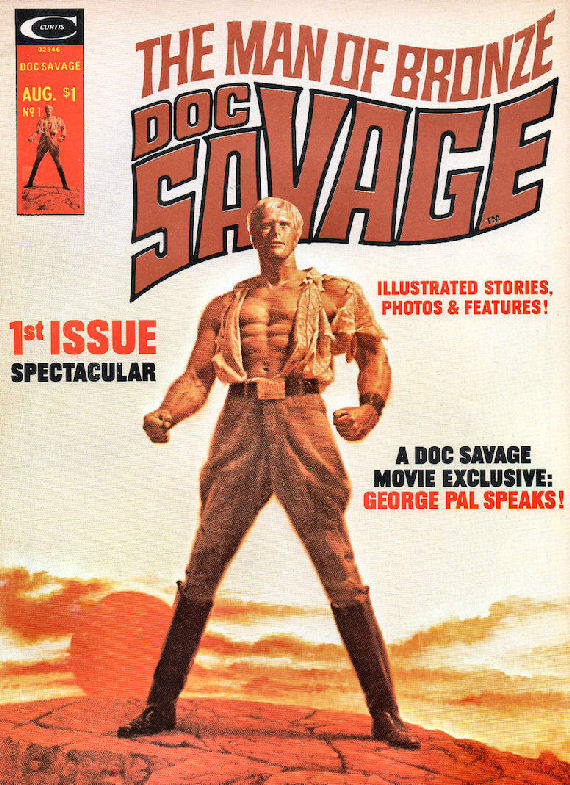
If you don’t recognize the man at left, it’s okay; he died years ago. But if you were around in the mid-1960s, you would certainly know his work. You might not remember the name Lester Dent, but you might know the name Kenneth Robeson. Kenneth Robeson was the name under which Dent (with a little help) wrote about a hundred and eighty books about Doc Savage, The Man of Bronze. Ah, now you recognize that name, don’t you? Bantam Books, in the 1960s, republished most, if not all, of the original stories written by Dent and others, with covers by (at least at first) James Bama, featuring a widow’s-peaked golden giant wearing jodhpurs and a half-ripped off shirt (Figure 2). Later covers were by Boris Vallejo and others.

Oh, I was very disappointed when the original Doc Savage books stopped coming; I think I had most of them. I briefly rejoiced when I heard George Pal was going to make a movie about Doc—this came out in 1975—but after seeing the movie there was a lot less rejoicing not only in our household but, I think, in most fan households and slanshacks. Why? Well, for one thing, the movie was a travesty; it didn’t respect its source material. It was a period piece, set in the ‘30s, but was intended as a spoof from the world “go.”

I watched it again the other day in preparation for writing this column, and I remain disappointed in its execution. Ron Ely (a former TV Tarzan, in case you didn’t know) was suitably big as Doc, and the storyline hewed fairly closely to the actual book (the first in the series). But all Doc’s vehicles were painted copper and included the logo seen in Figure 3. His sidekicks were nominally like their book counterparts, but not really. It was supposed to be lighthearted fun, but it came across to me as leadfooted parody.
Discounting some of the very late Doc Savage novels, which tried to minimize all the special characteristics (like his fantastic strength, his medical and scientific knowledge, his riches, and his companions), most of the books featured these characters: Clark Savage, Jr, known as “Doc,” who was one of the U.S.’s premier scientists, explorers, medical doctors, “scientific detectives,” inventors, and rich people. Thanks to his father’s (also a doctor) medical know-how saving an endangered “lost tribe” in South America, Doc received shipments of pure gold whenever needed. This gold allowed Doc to dedicate his life to fighting crime and improving the lives of his fellow humans. Doc was a giant of a man, but so perfectly proportioned that he didn’t appear outsized, normally.
Doc’s five aides and confidants were also acknowledged to be the top men in their respective fields. They had all met on the battlefields of WWI and became faithful friends of each other and Doc. They included Brigadier General Theodore Marley “Ham” Brooks, the best lawyer ever to graduate Magna Cum Laude from Harvard Law; Lt. Col. Andrew Blodgett “Monk” Mayfair, top man in industrial chemistry (and best friend and rival to Ham Brooks), who resembled a man-sized ape; Col. John “Renny” Renwick, construction engineer—known for his ham-sized fists that could knock down any door; Maj. Thomas J. “Long Tom” Roberts, electrical wizard and inventor; and William Harper “Johnny” Littlejohn, world-renowned archaeologist and geologist, who never used one syllable where three would do. (His favourite expression was “Well, I’ll be superamalgamated!”) Later, Dent added a niece, Pat Savage, who shared some of Doc’s characteristics.
These books were full of colourful characters—beginning with Doc and his aides—just the thing to catch the imagination of teen-aged me, and plenty of others. The books were giant-sellers for Bantam books, and though the writing was not of great literary quality, it was no more intrusive than any writing of the ‘30s and ‘40s destined for the popular markets, and better than many others. In fact, Doc Savage magazine lasted for years, and Doc appeared in magazines, comic books, radio and, as noted above, a film; it seems he captured the public’s imagination.
Several other attempts were made to bring Doc back to life; starting in the ‘80s, a young writer* named Will (William Patrick) Murray began writing for a series called The Destroyer (remember Remo Williams?), and from there branched out into a number of pulps; as of now, Will is the premier writer of pulp heroes like Doc Savage, writing or having written in the past The Shadow, The Spider, The Avenger, The Punisher, and several others, and keeping the tradition alive. This is not intended to be a comprehensive look at Will’s writing, by the way; he’s done comics and everything else you can think of related to superhero writing—along with Steve Ditko, he created the Marvel character Squirrel Girl, for one thing.
I have been a fan of Will’s writing since the Destroyer days—although credited to Warren Murphy and Richard Sapir, the series was farmed out to a number of people including Murray, Jim Mullaney, and Tim Somheil; as far as I know, the last original Destroyer book was an e-book (#151) called Bully Pulpit, credited to Warren Murphy “with R.J. Price.” But I digress; Will has written all kinds of superhero and pulp stuff, and is continuing to write it.

So let’s take a look at one of the recent Murray novels—credited on the cover only as by Kenneth Robeson (the house name under which all the original Doc stories were written); but credited as by Robeson and Dent. As it says in the intro, this was written by Will from an original Shadow novel by Dent; the book is an attempt to merge two fictional superheroes: Doc Savage and The Shadow!
The story concerns the first meeting of Doc and The Shadow—who, by the way, uses “Lamont Cranston” as an alias, but (to my surprise) is not really Cranston! (I won’t tell you more for fear of spoiling the surprise. I mean, I’ve thought of him for many, many years as being Cranston!) But the Shadow and Doc have totally different methods: Doc invented supermachine pistols that shoot “mercy bullets” which bring unconsciousness, then crooks are taken off to his sanatorium in the mountains to have their brains adjusted (don’t worry, he uses acupuncture) and to become functioning members of society. The Shadow, on the other hand, has twin .45 automatics (see Figure 4) and is not afraid to use them to eliminate the “bad guys” permanently, whereas Doc is against killing.
This novel uses Doc and his five aides. The Shadow has a radio program, but nobody knows—at least in the beginning—that the radio Shadow is actually a crime-fighter… in fact, only the criminals know that, and the few that find out are usually eliminated. Doc and his men aren’t sure whether the Shadow is a criminal or something else entirely.
All over New York, men—usually rich men—are dying earlier than they should, of “heart attacks.” It gradually becomes clear that someone who calls himself “The Funeral Director” is blackmailing men who have something to hide—maybe they acquired their wealth through less-than-legal (or even less-than-moral) means. If they don’t pay up they die. This Funeral Director is assisted by a number of “Undertakers” and at least one or two “Grave Diggers.”
It soon becomes clear to The Shadow that The Undertaker is someone he needs to eliminate; when he (The Undertaker) kidnaps Ham Brooks, Doc and his men are drawn into the struggle. But Doc is not sure whether he’s fighting one criminal or two.
Probably because this was at least partially based on an unfinished story by Dent himself, the writing appears extremely authentic. All the period details ring true; I was unable to detect any real anachronisms (which to me is a sign of good writing!). The story goes on a lot longer than a typical Doc Savage book; I’m not that familiar with the Shadow’s novels, but I’m guessing we have a book that’s as long as a Doc Savage book and a Shadow book together. Yet the action doesn’t flag; it kept me reading. If this is typical of the Will Murray-penned Doc Savage books, I’ll definitely be a steady customer—as there are a bunch of them left to read!
I have only a couple of concerns with this book: first, I think—and again, it’s probably because of Dent’s notes—the Shadow gets centre stage more than his share. Secondly, there are a few odd word choices: for example, the author seems to think that “sepia” is a synonym for “black” or “dark”—on more than one occasion, “sepia” is used for shadows that The Shadow has faded into. Not the world’s best camouflage, I’m thinking!
All in all, I really enjoyed that book—and the covers by Joe DeVito are a worthy successor to the Bama covers—and I’m looking forward to its direct sequel, Empire of Doom, which I also have. And I’m thinking of picking up a few of his other books, like King Kong vs. Tarzan! I give this a solid four flibbets! ¤¤¤¤
Post Scriptum: I had read a couple of months ago that Chris (“Thor”) Hemsworth was in talks with Shane Black, who is writing and directing, to play Doc in a new movie. I was excited, until I have now read that Dwayne “The Rock” Johnson has now been signed to play Doc. I think that not only does Dwayne have the size, but also the acting chops to play our hero; and I’m even more excited now. I can’t wait to see Black’s other casting choices. In case you don’t know who Black is, let me cite a few of the movies he’s written and/or helmed: Lethal Weapon (Mel Gibson and Danny Glover) plus LW2, LW3 and LW4; The Last Boy Scout (Bruce Willis and Damon Wayans); The Last Action Hero (Arnold Braunschweiger—that’s a joke from the movie, BTW); Kiss Kiss Bang Bang (Robert Downey, Jr., Val Kilmer, Michelle Monaghan); The Nice Guys (Ryan Gosling and Russell Crowe); and more.
*He’s six years younger than me; that counts as “young” as far as I’m concerned.
Comments? If you have anything to say—to add, to compliment, to argue with, or whatever—I’m here for you! You can comment here, or on Facebook. I usually see your comments shortly after you post them. They’re all welcome, whether you agree with what I have to say or not! My opinion is, as always, my own, and doesn’t necessarily reflect the views of Amazing Stories or its owner, editor, publisher or other columnists. See you next week!











Recent Comments